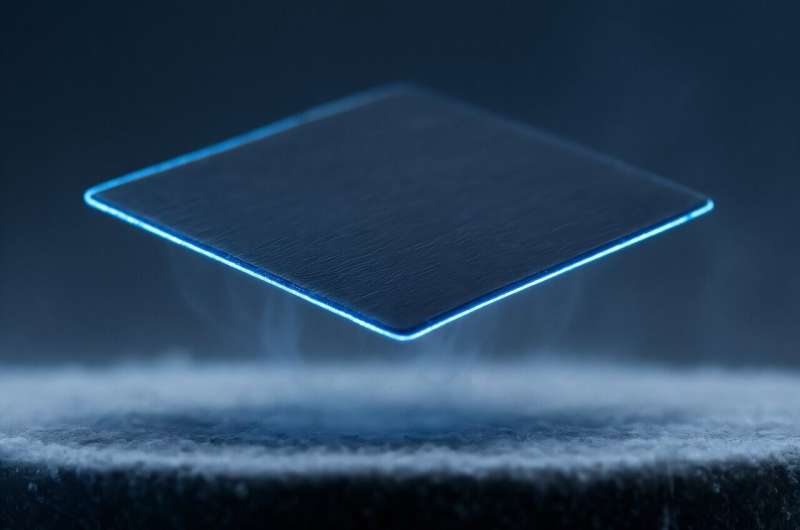Magnesium is a common chemical element, an alkaline earth metal, which is highly chemically reactive and is very light (even lighter than aluminum). Magnesium is abundant in plants and minerals and plays a role in human physiology and metabolism. In the cosmos, it is produced by large aging stars.
Among its physical properties, while it is a good conductor of electricity, magnesium is not known to be a superconductor. Superconductors are particularly promising materials with the potential to revolutionize energy transmission, medical imaging, and quantum computing, and are defined by their ability to conduct electricity without resistance below a certain critical temperature.
Recently, with my colleague Giovanni Ummarino from Turin Polytechnic, I have started challenging the textbook paradigm that states only certain elements in the periodic table can be superconductors. In particular, my colleague and I have shown that the phenomenon of quantum confinement can turn non-superconducting elements into superconductors. Our research is published in Condensed Matter.
Here by quantum confinement I mean the phenomenon in which the energy of a quantum particle, such as an electron, can greatly increase when it’s spatially confined, an effect that is ultimately due to the Heisenberg uncertainty principle—the more you constrain the spatial position of a quantum particle, the larger its energy fluctuations become.
In our previous work, my colleague and I have shown that this applies to noble metals such as gold, copper, and silver, which we predicted to become superconductors when processed into very thin sheets of about half a nanometer in thickness.
Now, our calculations predict that even magnesium can become a superconductor when processed into ultra-thin films of thickness lower than 1 nanometer (one-billionth of a meter). The calculations have no adjustable parameters and use ab-initio computations of the electronic and lattice structure of material. The key quantity which is predicted is the critical temperature at which the material turns from being a normal metal to being a superconductor, and is evaluated as a function of the film thickness.
Surprisingly, in this case, the critical temperature that can be reached by miniaturizing magnesium nano-sheets of about half nanometer thickness is as high as 10 Kelvin. This is an important consideration because it means that liquid helium can be used to cool the material down to achieve superconductivity instead of using much more expensive cooling technologies.
Indeed, the liquid helium cooling technology can be used down to 4.5 Kelvin, hence enabling the cooling of magnesium ultra-thin sheets to observe the predicted effect. This prediction, if confirmed experimentally, can radically transform the current technologies used for quantum electronics and quantum information and reduce their environmental impact.
This is evident if you consider that the most common material currently employed to make qubits (the fundamental unit of information, similar to a bit in classical computing, but can exist in a superposition of states, meaning it can represent 0, 1, or both simultaneously) is aluminum, which has a critical temperature of 1.6 Kelvin, hence below the liquid helium temperature.
If our prediction is confirmed, using magnesium instead of aluminum could lead to much more environmentally sustainable technologies for quantum computing.
This story is part of Science X Dialog, where researchers can report findings from their published research articles. Visit this page for information about Science X Dialog and how to participate.
More information:
Giovanni Alberto Ummarino et al, Possible Superconductivity in Very Thin Magnesium Films, Condensed Matter (2025). DOI: 10.3390/condmat10010017
Bio:
Alessio Zaccone received his Ph.D. from the Department of Chemistry of ETH Zurich in 2010. From 2010 till 2014 he was an Oppenheimer Research Fellow at the Cavendish Laboratory, University of Cambridge.
After being on the faculty of Technical University Munich (2014–2015) and of University of Cambridge (2015–2018), he has been a full professor and chair of theoretical physics in the Department of Physics at the University of Milano since 2022. Awards include the ETH Silver Medal, the 2020 Gauss Professorship of the Göttingen Academy of Sciences, the Fellowship of Queens’ College Cambridge, and an ERC Consolidator grant (“Multimech”).
Research contributions include the analytical solution to the jamming transition problem (Zaccone & Scossa-Romano PRB 2011), the analytical solution to the random close packing problem in 2d and 3d (Zaccone PRL 2022), the theory of thermally-activated reaction rate processes in shear flows (Zaccone et al PRE 2009), the theory of crystal nucleation under shear flow (Mura & Zaccone PRE 2016), the theoretical prediction of boson-like peaks in the vibrational spectra of crystals (Milkus & Zaccone PRB 2016; Baggioli & Zaccone PRL 2019), the theory of the glass transition in polymers (Zaccone & Terentjev PRL 2013), the theoretical and computational discovery of topological defects in glasses (Baggioli, Kriuchevskyi, Sirk, Zaccone PRL 2021), and the theoretical prediction of superconductivity enhancement effects due to phonon damping (Setty, Baggioli, Zaccone PRB 2020).
Research interests range from the statistical physics of disordered systems (random packings, jamming, glasses and the glass transition, colloids, nonequilibrium thermodynamics) to solid-state physics and superconductivity.
Citation:
Magnesium becomes a possible superconductor near the 2D limit (2025, April 1)
retrieved 1 April 2025
from https://phys.org/news/2025-03-magnesium-superconductor-2d-limit.html
This document is subject to copyright. Apart from any fair dealing for the purpose of private study or research, no
part may be reproduced without the written permission. The content is provided for information purposes only.

